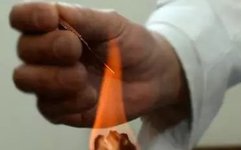↑↑ Follow us to start a healthy life ↑↑
History of Fire Needle
The fire needle therapy involves heating a specially designed metal needle until it is red hot, then quickly inserting it into acupuncture points (xue) or specific areas to provide thermal stimulation for treating diseases.
The fire needle is a form of acupuncture, historically known as “burning needle” (fan zhen). The technique of fire needle insertion is referred to as “quenching insertion” (chuan ci). It can be categorized into methods such as meridian point insertion, painful point insertion, dense insertion, surrounding insertion, and dispersing insertion.
The “Lingshu: Official Needle” states: “Quenching insertion refers to using a burning needle to treat bi syndrome (obstruction).” Ming dynasty physician Wu Kun further explained: “Quenching insertion involves first heating the needle with fire and then inserting it, which treats cold bi syndrome located in the bones.”
In the Tang dynasty, Sun Simiao recorded in the “Emergency Formulas Worth a Thousand Gold” that: “For external boils and abscesses, the needle must be extremely hot.” This is the earliest record of fire needle therapy for treating heat syndromes. Fire needle therapy not only treats bi syndromes and sores but also has unexpectedly effective results for various difficult and complicated diseases.
Fire needle therapy has a long history and is characterized by its simplicity of operation and rapid effectiveness. It is applicable across various clinical departments and has a wide range of applications.
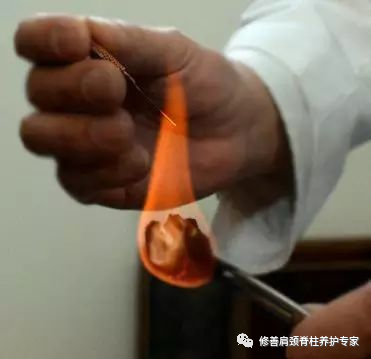
Principles of Fire Needle
Assisting Yang with Fire
Utilizing heat from fire, stimulating the meridian qi through acupuncture points and meridians, and warming and strengthening Yang qi is the foundation of fire needle therapy.
Opening the Door to Expel Evil
By cauterizing acupuncture points and skin pores, it opens the external pathways of the meridians, allowing evils such as pus, blood stasis, dampness, phlegm, and the six excesses to exit, thus eliminating the root cause of the disease.
Using Heat to Draw Out Heat
By using fire to open the external pathways, toxins can be expelled, which is essential for treating diseases.
Through these actions, fire needle therapy achieves effects such as warming and strengthening Yang qi, promoting tissue regeneration, dispersing cold and dampness, alleviating itching, removing blood stasis and pus, reducing swelling, relieving pain, stopping cough, calming wheezing, and clearing heat, draining fire, and detoxifying.
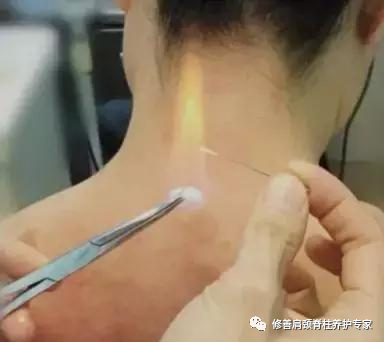
Instruments for Fire Needle
The needles used for fire needle therapy must be made of tungsten alloy materials that can withstand high temperatures, do not lose temper, deform less, and have high hardness at elevated temperatures. They resemble filiform needles but are thicker, with the needle handle often wrapped in copper wire.
Common types include single-headed fire needles and three-headed fire needles, with single-headed fire needles further categorized into fine fire needles (needle tip diameter approximately 0.5mm) and coarse fire needles (needle tip diameter approximately 1.2mm).
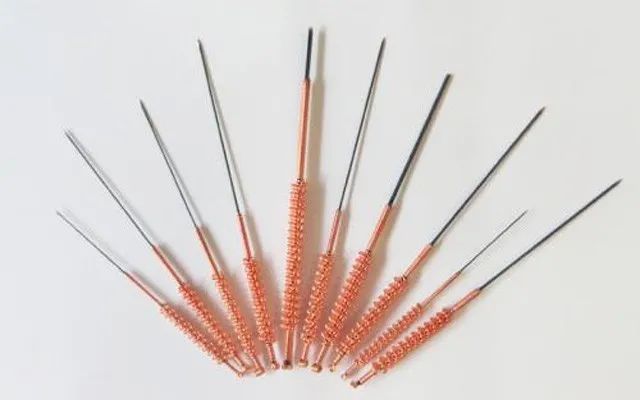
Methods of Fire Needle Operation
Selection of Points and Disinfection
The selection of points for fire needle therapy is similar to that of filiform needle acupuncture, but fewer points are chosen, primarily using the method of “using pain as the point” for local point selection.
Before needling, the skin at the acupuncture point must be strictly disinfected, first with iodine and then with ethanol to remove the iodine.
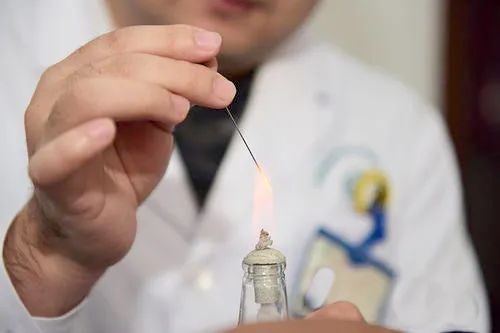
Heating the Needle and Insertion
Heating the needle is a critical step in using the fire needle. The “Great Compendium of Acupuncture: Fire Needle” states: “Heat it over a lamp until it glows red; this is effective; if it is not red, it cannot treat the disease and may harm the patient.” Therefore, the needle must be heated until red before use.
When heating the needle, heat the needle body first, then the needle tip. Depending on the treatment needs, the needle can be heated to white hot, glowing red, or slightly red.
-
If the insertion is deeper, it should be heated to white hot for quick insertion and withdrawal; otherwise, it is difficult to insert and withdraw, causing severe pain.
-
If the insertion is shallower, it can be heated to glowing red for quick insertion and withdrawal, with light and shallow puncturing.
-
If the insertion is very superficial, it can be heated to slightly red and lightly cauterized at the skin level.
During insertion, hold the lit alcohol lamp with the left hand and the needle with the right hand, keeping it as close to the treatment area as possible. After heating the needle, insert it vertically into the acupuncture point quickly and withdraw it quickly.
Depending on the treatment method, the needle may be left in place for 5-15 minutes before withdrawal.
After withdrawal, apply sterile dry cotton balls to press the needle hole to reduce pain and prevent bleeding.
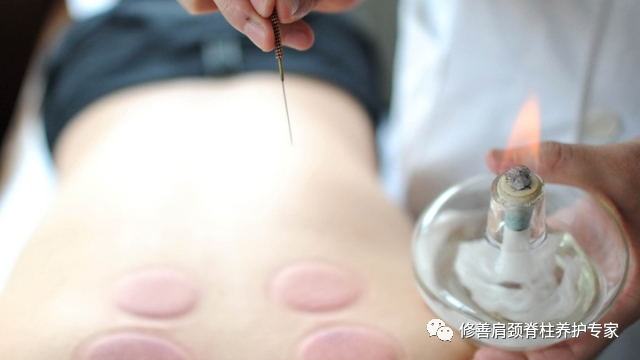
Depth of Insertion
The depth of insertion should be determined based on the condition, constitution, age, and the thickness of the muscle, depth of blood vessels, and distribution of nerves at the insertion site.
The “Great Compendium of Acupuncture: Fire Needle” states: “Avoid inserting too deeply, as it may injure the meridians; too shallow cannot treat the disease, only a slight sensation is felt.”
Generally, for the limbs and lower abdomen, a depth of 2-5 fen is appropriate; for the chest and back, a shallower depth of 1-2 fen is recommended; for moles and warts, the depth should be based on the base depth.
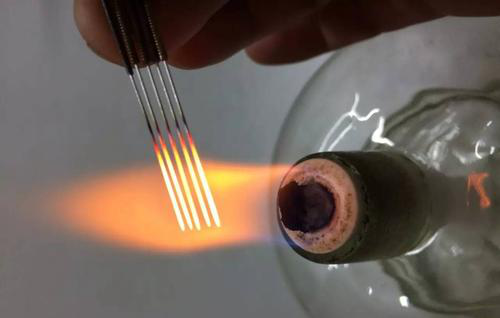
Indications for Fire Needle
Fire needle therapy has effects such as warming the meridians, dispersing cold, invigorating blood circulation, softening hard masses, and promoting tissue regeneration. It is commonly used in clinical practice to treat conditions such as wind-cold-damp bi syndrome, herpes zoster, chronic colitis, impotence, dysmenorrhea, abscesses, hemorrhoids, lymphadenitis, tennis elbow, ganglion cysts, axillary odor, elephantiasis, malnutrition, and warts.
Below are several clinical applications shared.
Filiform and Fire Needle Treatment for Herpes Zoster
Xu used a 26-gauge 1.5-inch filiform needle heated over an alcohol lamp, quickly inserted it into the rash, and immediately withdrew the needle, puncturing each vesicle once and applying purple medicine.
Fire Needle Treatment for Shoulder Periarthritis
Summer used a 20-22 gauge coarse needle or a sewing needle, wrapped the base with cotton thread, heated it until red and white over an alcohol lamp, quickly inserted it into the affected side’s jianyu point, and quickly withdrew the needle, applying sterile gauze to cover the needle hole once a week.
Injection Needle Fire Needle Treatment for Strangulated Internal Hemorrhoids
Zhang lightly pressed to locate the center of the hemorrhoid, used a 7-gauge injection needle heated over a lamp, dipped it in sulfur powder, quickly inserted it into the center of the hemorrhoid, and immediately withdrew the needle, then applied gauze externally and performed a sitz bath with Sichuan pepper water.
Fire Needle Treatment for Low Back Pain
Zheng divided the points into two groups, one group using weizhong, shenxu, and yaoyan, and the other group using kunlun, qihai, and zhishi, alternating between the two groups. The fire needle was electrically heated until the needle tip glowed red, inserted 3-5 mm into the points, and quickly withdrawn.
Portable Electronic Fire Needle Treatment for Surgical Conditions
Connect the power, turn on the electronic fire needle device, hold the fire needle handle, and press the switch until the needle tip glows red before operation. Aim the fire needle at the center of the lesion, quickly cauterizing to the base. For treating papillomas, first pull the papilloma outward with tweezers, then place the fire needle horizontally after heating, cutting from the base, which can remove it in seconds. Xu used this method to treat common warts, pigmented nevi, papillomas, flat warts, keratoacanthomas, sebaceous adenomas, and corns.
Fire Needle Treatment for Pigmented Nevi and Warts
Ma used fire needles developed by Ansteel Automation in three diameters: 0.25, 0.5, and 1.0 mm, heating the needle tip over a lamp, quickly cauterizing the affected area, and repeating until complete destruction.
Fire Needle with Cupping Therapy for Knee Joint Effusion
Routine disinfection of the affected area, using a fine fire needle heated to incandescent, quickly puncturing at the highest point of the joint. If effusion occurs, puncture 5-7 times; if the effusion is thick and difficult to expel, use a coarse fire needle heated red to puncture, then perform flash cupping, which can expel light yellow effusion. Bandage to stabilize the knee joint. After the effusion is eliminated, switch to local acupuncture points.
Fire Needle Treatment for Lateral Epicondylitis (Tennis Elbow)
Locate the tender points between the lateral epicondyle and the radial neck. After routine disinfection, quickly insert the fire needle into 2-3 points, leaving the needle for 1-2 minutes. Cupping for 10 minutes after needle withdrawal.
Fire Needle Bloodletting Treatment for Gout
Main points: xingjian, taichong, neiting, and xian gu. For damp-heat accumulation, add qiu xu, da du, and tai bai; for blood-heat stagnation, add xue hai and ge shu; for phlegm-damp stagnation, add feng long and pi shu; for liver and kidney yin deficiency, add tai xi and san yin jiao, all taken from the affected side. Use coarse fire needles for foot points and fine fire needles for other points. After disinfection, quickly insert the fire needle, withdrawing it quickly, to a depth of 0.3-1 inch, with 1-3 needles per point. For foot points, bleeding should be controlled to less than 100ml per session.
Fire Needle Warming Method for Alopecia Areata
Points: ashi points, shenxu, and ganxu. Use three-headed fire needles for ashi points and single-headed fire needles for the other two points, disinfecting the area before quickly puncturing the heated fire needle at the points.
Fire Needle with External Application on Yongquan Point for Recurrent Oral Ulcers
Expose the wound (if the wound is too large or numerous, perform mucosal anesthesia first), puncture the wound with a heated fire needle, ensuring to clean without damaging normal mucosa. Then mix aged vinegar with evodia to form a paste, apply it to the yongquan point, and secure it with musk bone plaster for 24 hours.
Fire Needle as Primary Treatment for Recalcitrant Facial Nerve Paralysis
Points: yuyao, sizhuzhong, cuanzhu, sibai, yangbai, xiaguan, yingxiang, dicang, jiaoche, taiyang, and touwei, selecting 5-6 points each time. For body points, use hegu, zusanli, and taichong. Use a single-headed fire needle with a diameter of 0.5 mm, puncturing the points quickly without leaving the needle; then use a filiform needle for additional needling with even tonification and reduction methods.
Fire Needle Treatment for Fluorosis
Points: jiaji points and ashi points. Heat the fire needle to white hot, quickly insert and withdraw to a depth of about 1 inch, followed by cupping with bamboo cups (using warm herbal decoction), changing when it cools, for 30-60 minutes each session. Fluorosis is a type of endemic disease, and the number of selected points depends on the individual and symptoms.
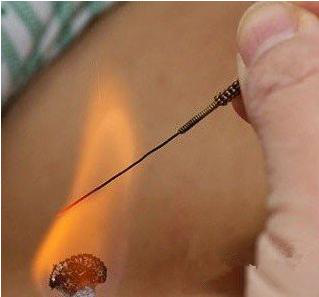
Common Adverse Reactions and Causes of Fire Needle
Pain
After fire needle therapy, there is generally only a slight burning pain or warmth that quickly disappears within minutes to tens of minutes.
If the patient experiences severe pain, it is often due to insufficient heating of the fire needle.
Bleeding
Bleeding during fire needle insertion is a common phenomenon, as the fire needle has the effect of opening large pores and is often used as an effective tool for bloodletting and expelling evils.
If a subcutaneous blood vessel is accidentally punctured and bleeding does not stop, apply a cotton ball to the needle hole and press the area for ten minutes.
Patients with hemophilia or coagulation disorders should avoid fire needle therapy.
Infection
Fire needle therapy itself is a benign local mild burn and generally does not lead to infection.
Local needling may cause small areas of redness and swelling, with mild itching, and some individuals may experience systemic reactions such as mild chills and fever, which are normal responses due to the aseptic inflammatory reaction from the burn.
Scarring
After fire needle puncture, scabs usually fall off in about two weeks without leaving scars.
If the needle hole becomes infected and pus forms, scarring is likely to occur.
Needle Shock
Due to the rapid action of fire needle operations and the relatively mild pain, needle shock is not commonly seen.
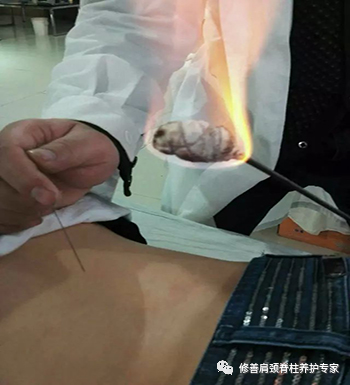
Precautions for Fire Needle
Practitioner
-
Patients with hemophilia or coagulation disorders should avoid fire needle therapy.
-
Fire needle therapy should not be used in areas with major blood vessels, nerve trunks, or vital organs.
-
Except for treating nevi and warts, fire needle therapy is prohibited on the face. However, if a fine fire needle is used for shallow puncturing, it can treat diseases without leaving scars, so the prohibition is not absolute.
-
Patients who are overly anxious, hungry, fatigued, or intoxicated should avoid fire needle therapy.
-
For patients with weak constitutions, care should be taken regarding their position during treatment.
-
For patients receiving fire needle therapy for the first time, proper explanations should be provided to alleviate fears and prevent needle shock.
Patient
-
During fire needle treatment, avoid eating cold foods.
-
After fire needle treatment, maintain cleanliness to prevent wound infection.
-
During bathing, take care to prevent dirty water from entering the needle hole.
-
If itching occurs at the needle site, do not scratch to prevent infection.
-
If the needle is inserted 1-3 fen deep, no special treatment is needed after withdrawal. If inserted 4-5 fen deep, cover the needle hole with sterile gauze and secure it with tape for 1-2 days to prevent infection.
Disclaimer:
All suggestions in this article are for reference only and cannot replace professional medical diagnosis or prescriptions. Please do not attempt without professional guidance. Readers should carefully assess their health conditions and choose suitable health maintenance plans.
Some content in this article is sourced from the internet, and the text, materials, and images are copyrighted by the original authors. If your legal rights are infringed, please contact us, and we will delete the relevant content promptly.

Long press the QR code below for professional health consultation.


Give a “like” and “view”!
Your encouragement is our motivation!

